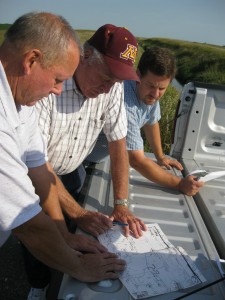
Discovery Farms is one of several farmer-supported ventures that seeks to help farmers better manage nitrogen, improve soil health and protect water quality.
When it comes to water quality in Minnesota, agency report after agency report and media story after media story paint a bleaker and bleaker picture. If you read enough of these reports and stories – and we read them all here at the Minnesota Corn office – you feel like Minnesota’s water quality is beyond repair.
The finger is pointed at agriculture as a major cause of water degradation in almost all of these reports or media pieces. More specifically, nitrogen fertilizer, tillage methods, planting more corn acres, and even ethanol are blamed.
That’s why we read them all here at Minnesota Corn and take action as necessary. But is our state’s water quality situation really as hopeless as these reports and media outlets would have you believe? We don’t think so.
A recent report from the Minnesota Pollution Control Agency (MPCA) showed reductions in five of seven pollutants – including phosphorus and sediment – found in Minnesota waterways over a 30-year span. Unfortunately, this report did not receive the amount of attention that all the negative reports usually receive.
To be clear, we are not arguing that Minnesota’s water quality is where it needs to be. We’re also not arguing that agriculture has not played a role in the current state of our lakes, streams and rivers. What we are arguing is this: Minnesota’s water quality status is not all doom and gloom. There is ample opportunity to make improvements in all sectors, and agriculture can be one of the leading contributors toward those improvements.
As the MPCA report indicated, we’re already seeing improvement in several areas. Agriculture has worked hard over the years to reduce sediment and phosphorus runoff and it appears those efforts are paying off.
The report also showed that agriculture has some work to do when it comes to improving how we manage nitrogen fertilizer.
Mission accepted.
Minnesota corn farmers voluntarily contribute one cent of every bushel of corn sold to our state’s corn “check-off.” The vast majority of those funds – about $4 million annually – support research efforts that address agriculture and water quality. Most farmer-funded research efforts are performed by accredited institutions like the University of Minnesota.
Of Minnesota Corn’s 33 active research projects, 20 are focused on helping farmers better manage nitrogen fertilizer to reduce loss and improve water quality. Check-off funds also support several faculty positions at the U of M with a nutrient management and water quality focus. There are also on-farm initiative such as Discovery Farms supported by check-off funds.
In addition, Minnesota Corn received tremendous response from farmers applying to the new Conservation Innovation grant program, which provides funding support for farmers to try using new nitrogen management and soil health practices that may better protect water quality.
It won’t happen overnight, but with continued investment, dedication and collaboration, we will see those nitrogen numbers trend in a more positive direction, much like we’ve seen the sediment and phosphorus numbers take a turn for the better.
No, Minnesota’s water quality outlook is not all doom and gloom. We definitely have work to do, but we’ve already shown that we can make progress if we’re committed to it and work together.

